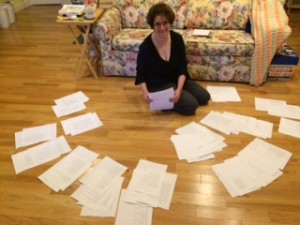At this time of year, you may be contemplating New Year’s resolutions to finish writing projects and send out more work to publishers. This true-life vignette by a regular contributor to Reiter’s Block is both timely and a poignant reminder that our creative egos are not the center of everyone’s universe. Spinning storylines from small details is great between the pages of a book, but sometimes this aspect of our minds makes us miss what’s really happening in a relationship.
The First of the Year
by Donal Mahoney
Anyone who has had poetry published by an editor over the years has a relationship with that editor whether one knows it or not.
Sometimes the relationship is lukewarm, other times bordering on friendship, occasionally deep. Over time, writer and the editor notice mannerisms in each other that are often never discussed since these insights have nothing to do with the work and time may be important to one or both. That’s happened to me with editors over the years but never with such impact as happened in an incident that occurred not long ago.
This editor has accepted my work on a regular basis and has kept his distance, a safe place to be for anyone dealing with writers, most of whom know how good they are. Every once in awhile, however, he would tell me that my writing reminded him of some author I had never read. I had always heard of the authors, some of them alive, others recently dead, all very good writers by the standards of this era. He would usually recommend a book or two by each author that he would say I should read. This was the only time he would border on the imperative. Otherwise he would sound as if he had been reading The New Yorker since birth.
This kind of response from an otherwise detached but intelligent editor is invigorating. To be compared to a good writer one has never read has a double benefit: One must be writing some things well. And one must not be subliminally plagiarizing the style of the author mentioned since he has never read him or her.
In the last couple of months, however, this meticulous editor hasn’t published a new issue, something he has done every month in the years since I first encountered his site. I had no idea what might be the matter. Stranger still, I had heard nothing from him and he was always one to respond.
I began thinking that maybe his failure to write might have had something to do with the last two pieces I had sent him. The content of both would be politically incorrect in his eyes but not in mine. I sent the pieces because it’s good at times to get a reaction from someone whose taste you admire but who may not agree with you on the issues of the day or on the bigger issues of life.
Not hearing from him on the controversial pieces, I decided to send him a short story and a poem I thought he would like. Not too hot, not too cold, perhaps just right. Maybe he needed copy. Maybe for some odd reason submissions to his site were down.
A week later he wrote back and apologized for the delay in getting back to me. He said he liked the work I had just sent, did not mention the controversial pieces, and added that he would be putting his site on hiatus till “after the first of the year.” Then he said, almost as a casual afterword, that he could not recall if he had told me that he has Stage 4 cancer. The email ended on that note.
No, he had not told me that tremulous fact and I mentioned that in my reply. I took a chance and said that if he ever simply wanted to sound off about something, I’d be happy to hear from him. I knew nothing about him or his life so I might be a safe place, I thought, for him to air whatever goes through the mind of someone with Stage 4 cancer.
So far he has not written back.
It will be hard waiting for the “after” that I hope comes “after the first of the year.”

